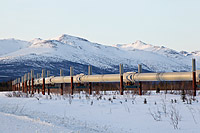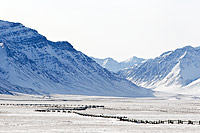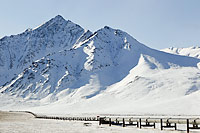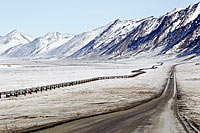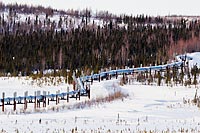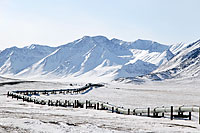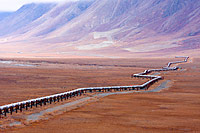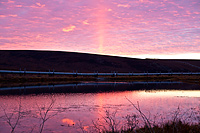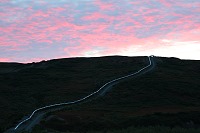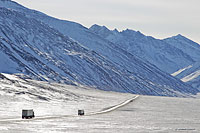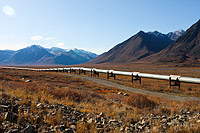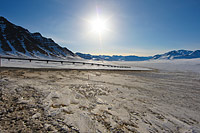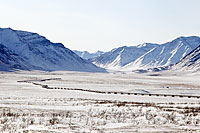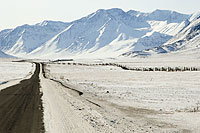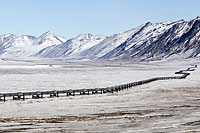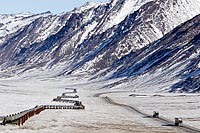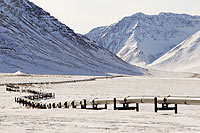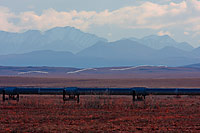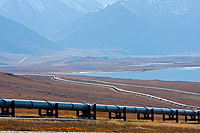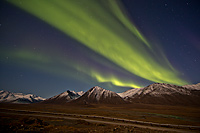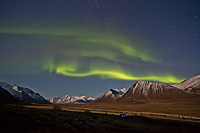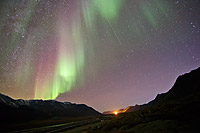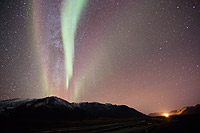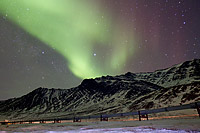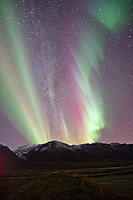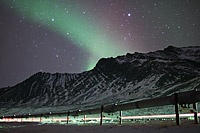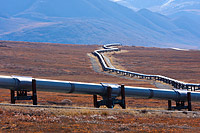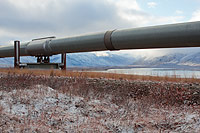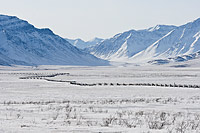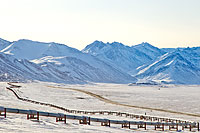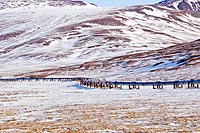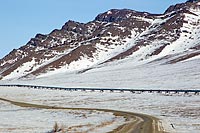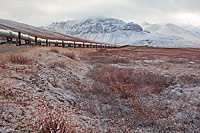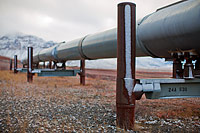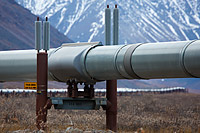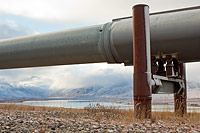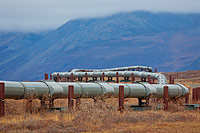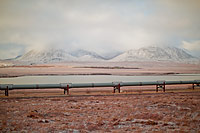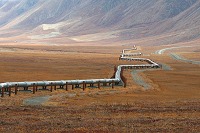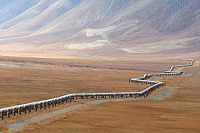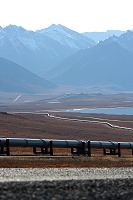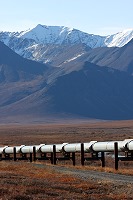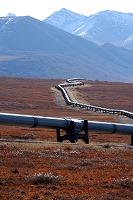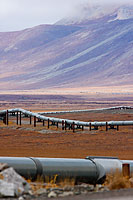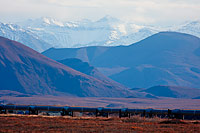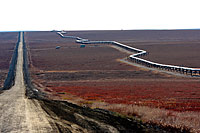 |
~ TRANS ALASKA PIPELINE ~
| |
|
The 800 mile Trans Alaska Pipeline brings crude oil from the North Slopes of Alaska
to the ice free port of Valdez.
|
|
Pipeline Map
 |
|
|
|
|
Aurora Over Pipeline
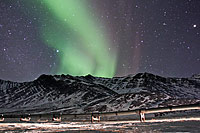 |
|
|
Construction on the ambitious Pipeline project started in 1974. Three years and $8 billion later, North Slope crude oil
started flowing through TAPS in June 1977.
At its peak, the Trans Alaska Pipeline System carried over 2 million barrels of crude oil per day.
Nowadays, with declining oil production, the flow has decreased to approximately 600,000 barrels per day.
|
|
Subject:
Operated by:
|
Trans Alaska Pipeline
Alyeska Pipeline Service Company
|
Length:
Diameter:
|
800 miles
48 inches
|
Peak Flow:
Current Flow:
|
2.1 million barrels per day (1988)
Approx. 600K barrels per day (2012)
|
Pump Stations:
|
11 Pump Stations (6 active)
|
Ownership:
|
BP
ConocoPhillips
ExxonMobil
Koch
Chevron
|
| |
|
|
|
Alyeska Pipeline in the Dark of Night |
|
|
As the sun slowly sets down in the vast Alaskan landscape, the sky turns a bright shade of pink before the night reveals the stars.
Photos of the Trans Alaska Pipeline at sunset...
|
|
Pipeline Sunset
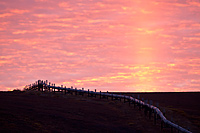 |
|
|
Star Trail with Aurora
 |
|
|
|
|
|
|
In the middle of the winter, the nights are bitter cold. However, for those who are not afraid to brave the elements, they might witness
a spectacular light show...
|
|
Photos of the Trans Alaska Pipeline with Aurora in the middle of the winter.
|
|
|
|
|
|
|
Lush Summer
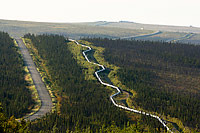 |
|
|
Golden Fall
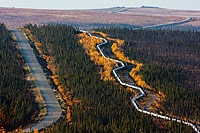 |
|
|
Cold Winter
 |
|
|
TAPS is immune to the changing of the seasons. Being a major contributor to the US crude oil production, the Trans Alaska Pipeline
System operates 24 hours a day, all year long. Only major maintenance during the Turn Around periods (TAR) will affect production.
|
|
|
|
|
Atigun Pass
 |
|
|
|
|
Spring, Summer, Fall or Winter, the show must go on to supply the US energy needs.
Far Left: Atigun Pass mid Summer.
|
|
|
Crude oil production from the Alaska North Slopes has been steadily declining at an annual rate of 4 to 5%.
Low oil throughput is cause for concern. Indeed, under its current configuration, TAPS will be marred
with operational issues if the flow drops below a minimum of 400,000 barrels per day.
|
|
|
|
|
|
|
|
|
|
At the current rate of decline, TAPS production is projected to reach the minimum threshold within the next decade.
|
|
|
|
|
|
|
The original TAPS design had as many as 12 Pump Stations to handle peak volume, although only 11 were actually built (Pump Station 11 was never built).
Significant investment will be needed to mitigate the problems linked to low oil flow.
|
|
|
In 2004, the Strategic Reconfiguration project
was started, aiming to overhaul 4 Pump Stations with state-of-the-art Electric Pumps with Variable Frequency Drives
(at Pump Stations 1, 3, 4 and 9).
|
|
|
|
Atigun Pass
 |
|
|
Pipeline North of Brooks Range
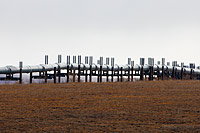 |
|
|
|
|
Nowadays among the active Pump Stations, PS 1, 3, 4 and 9 are the main stations responsible for pushing crude oil through the 48" pipeline. They
benefited from the Strategic Reconfiguration project which upgraded the equiment to Electric Pumps with Variable Frequency Drives.
The VFDs enable to mitigate some of the operational issues related to reduced oil flow.
|
|
|
Pump Station 7, in interior Alaska, is also active.
Pump Station 5 is actually a relief station designed to slow down the flow of oil coming down from the Brooks Range.
Pump Stations 2, 6, 8, 10 and 12 were put on standby, but could be brought back in service within 6 months if needed.
Pump Station 11 was never built.
|
|
|
|
|
Northern Lights over Pipeline |
|
|
In Alaska, the nights are cold, but when you are in the middle of nowhere, the stars are particularily bright. Tonight, the auroras
are making an appearance above the pipeline.
|
|
|
|
Aurora Above Pipeline
 |
|
|
Photos of the Trans Alaska Pipeline with Aurora in the middle of the winter.
|
|
Aurora and Milky Way
 |
|
|
|
|
|
Purple and Green Aurora
 |
| |
Purple, yellow and green streaks of light paint the night sky and across the Milky Way.
|
|
|
|
|
The Alyeska Pipeline Service Company (APSC) is the operator of the 800 mile long pipeline.
|
|
|
Pipeline in Frozen Landscape |
|
|
|
|
Photos of the Trans Alaska Pipeline during the winter.
|
|
|
|
|
|
|
The pipeline zigzags across the Alaskan landscape. This is in fact by design, in order to withstand small to medium earthquakes.
|
|
|
|
|
Pipeline across the Arctic Tundra
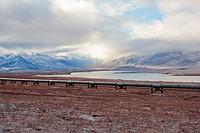 |
|
|
|
|
|
Below: When the pipeline is above ground, many of the supports are fitted with heat sinks designed to dissipate the heat coming the oil.
This was an important design consideration to mitigate impacts to the permafrost.
|
|
|
|
|
|
The pipeline snakes across the tundra in the Brooks Range.
|
|
|
|
|
|
|
|
Pictures of the Trans Alaska Pipeline at various locations along the Dalton Highway.
|
|
|
|
|
|
Go to the Moon & Get the Best Pictures
...Smile... ' Click! '

[email protected]
© Copyright Go2Moon, Alaska

